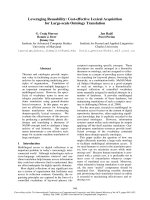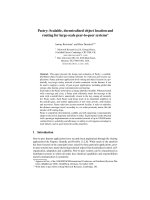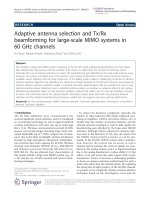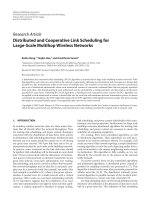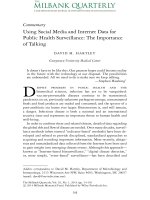Efficient and effective data cleansing for large database
Bạn đang xem bản rút gọn của tài liệu. Xem và tải ngay bản đầy đủ của tài liệu tại đây (570.11 KB, 148 trang )
EFFICIENT AND EFFECTIVE
DATA CLEANSING FOR LARGE DATABASE
LI ZHAO
NATIONAL UNIVERSITY OF SINGAPORE
2002
EFFICIENT AND EFFECTIVE
DATA CLEANSING FOR LARGE DATABASE
LI ZHAO
(M.Sc., NATIONAL UNIVERSITY OF SINGAPORE)
A THESIS SUBMITTED
FOR THE DEGREE OF DOCTOR OF PHILOSOPHY
DEPARTMENT OF COMPUTER SCIENCE
NATIONAL UNIVERSITY OF SINGAPORE
2002
Acknowledgments
It’s my pleasure to express my greatest appreciation and gratitude to my supervi-
sor: Prof. Sung Sam Yuan. He provided many ideas and suggestions. It has been
an honor and pleasure to work with him. Without his support and encouragement,
this work would not have been possible.
Also I would like to thank my parents and my wife for their constant encour-
agement and concern. I am very grateful to their care, support, understanding
and love.
Foremost, I am very thankful to NUS for the Research Scholarship, and to
the department for providing me excellent working conditions during my research
study.
i
Contents
1 Introduction 1
1.1 Background . . . . . . . . . . . . . . . . . . . . . . . . . . . . . . . 1
1.2 Contributions . . . . . . . . . . . . . . . . . . . . . . . . . . . . . . 12
1.3 Organization of the Thesis . . . . . . . . . . . . . . . . . . . . . . . 14
2 Previous Works 16
2.1 Pre-processing . . . . . . . . . . . . . . . . . . . . . . . . . . . . . . 17
2.2 Detection Methods . . . . . . . . . . . . . . . . . . . . . . . . . . . 18
2.3 Comparison Methods . . . . . . . . . . . . . . . . . . . . . . . . . . 29
2.3.1 Rule-based Methods . . . . . . . . . . . . . . . . . . . . . . 30
2.3.2 Similarity-based Methods . . . . . . . . . . . . . . . . . . . 33
2.4 Other Works . . . . . . . . . . . . . . . . . . . . . . . . . . . . . . . 45
3 New Efficient Data Cleansing Methods 47
3.1 Introduction . . . . . . . . . . . . . . . . . . . . . . . . . . . . . . . 47
3.2 Properties of Similarity . . . . . . . . . . . . . . . . . . . . . . . . . 50
3.3 LCSS . . . . . . . . . . . . . . . . . . . . . . . . . . . . . . . . . . . 52
ii
Contents iii
3.3.1 Longest Common Subsequence . . . . . . . . . . . . . . . . . 52
3.3.2 LCSS and its Properties . . . . . . . . . . . . . . . . . . . . 54
3.4 New Detection Methods . . . . . . . . . . . . . . . . . . . . . . . . 56
3.4.1 Duplicate Rules . . . . . . . . . . . . . . . . . . . . . . . . . 57
3.4.2 RAR1 . . . . . . . . . . . . . . . . . . . . . . . . . . . . . . 59
3.4.3 RAR2 . . . . . . . . . . . . . . . . . . . . . . . . . . . . . . 66
3.4.4 Alternative Anchor Records Choosing Methods . . . . . . . 69
3.5 Transitive Closure . . . . . . . . . . . . . . . . . . . . . . . . . . . . 72
3.6 Experimental Results . . . . . . . . . . . . . . . . . . . . . . . . . . 77
3.6.1 Databases . . . . . . . . . . . . . . . . . . . . . . . . . . . . 77
3.6.2 Platform . . . . . . . . . . . . . . . . . . . . . . . . . . . . . 78
3.6.3 Performance . . . . . . . . . . . . . . . . . . . . . . . . . . . 78
3.6.4 Number of Anchor Records . . . . . . . . . . . . . . . . . . 84
3.7 Summary . . . . . . . . . . . . . . . . . . . . . . . . . . . . . . . . 89
4 A Fast Filtering Scheme 91
4.1 Introduction . . . . . . . . . . . . . . . . . . . . . . . . . . . . . . . 91
4.2 A Simple and Fast Comparison Method: TI-Similarity . . . . . . . 95
4.3 Filtering Scheme . . . . . . . . . . . . . . . . . . . . . . . . . . . . 100
4.4 Pruning on Duplicate Result . . . . . . . . . . . . . . . . . . . . . . 102
4.5 Performance Study . . . . . . . . . . . . . . . . . . . . . . . . . . . 105
4.5.1 Performance . . . . . . . . . . . . . . . . . . . . . . . . . . . 105
4.6 Summary . . . . . . . . . . . . . . . . . . . . . . . . . . . . . . . . 110
Contents iv
5 Dynamic Similarity for Fields with NULL values 111
5.1 Introduction . . . . . . . . . . . . . . . . . . . . . . . . . . . . . . . 111
5.2 Dynamic Similarity . . . . . . . . . . . . . . . . . . . . . . . . . . . 112
5.3 Experimental Results . . . . . . . . . . . . . . . . . . . . . . . . . . 119
5.4 Summary . . . . . . . . . . . . . . . . . . . . . . . . . . . . . . . . 121
6 Conclusion 122
6.1 Summary of the Thesis Work . . . . . . . . . . . . . . . . . . . . . 122
6.2 Future Works . . . . . . . . . . . . . . . . . . . . . . . . . . . . . . 123
Bibliography 124
A Abbreviations 137
List of Figures
2-1 The merge phase of SNM. . . . . . . . . . . . . . . . . . . . . . . . 20
2-2 Duplication Elimination SNM. . . . . . . . . . . . . . . . . . . . . . 24
2-3 A simplified rule of equational theory. . . . . . . . . . . . . . . . . . 31
2-4 A simplified rule written in JESS engine. . . . . . . . . . . . . . . . 32
2-5 The operations taken by transforming “intention” to “execution”. . 35
2-6 The dynamic programming to compute edit distance. . . . . . . . . 36
2-7 The dynamic programming . . . . . . . . . . . . . . . . . . . . . . . 38
2-8 Calculate SSNC in MCWPA algorithm. . . . . . . . . . . . . . . . 43
3-1 The algorithm of merge phase of RAR1. . . . . . . . . . . . . . . . 62
3-2 The merge phase of RAR1. . . . . . . . . . . . . . . . . . . . . . . . 63
3-3 The merge phase of RAR2. . . . . . . . . . . . . . . . . . . . . . . . 68
3-4 The most record method. . . . . . . . . . . . . . . . . . . . . . . . . 70
3-5 Varying window sizes: the number of comparisons. . . . . . . . . . . 84
3-6 Varying window sizes: the comparison saved. . . . . . . . . . . . . . 85
3-7 Varying duplicate ratios. . . . . . . . . . . . . . . . . . . . . . . . . 85
3-8 Varying number of duplicates per record . . . . . . . . . . . . . . . 86
v
List of Figures vi
3-9 Varying database size: the scalability of RAR1 and RAR2. . . . . . 86
3-10 The values of c
ω
(k) over ωN for different k with ω = 30. . . . . . . 89
4-1 The filtering and pruning processes. . . . . . . . . . . . . . . . . . . 94
4-2 The fast algorithm to compute field similarity. . . . . . . . . . . . . 97
4-3 Varying window size: time taken. . . . . . . . . . . . . . . . . . . . 106
4-4 Varying window size: result obtained. . . . . . . . . . . . . . . . . . 107
4-5 Varying window size: filtering time and pruning time. . . . . . . . . 107
4-6 Varying duplicate ratio: time taken. . . . . . . . . . . . . . . . . . . 109
4-7 Varying database size: scalability with the number of records. . . . 109
5-1 The number of Duplicates Per Record. . . . . . . . . . . . . . . . . 121
List of Tables
1.1 Two records with a few information known. . . . . . . . . . . . . . 7
1.2 Two records with more information known. . . . . . . . . . . . . . . 7
2.1 Example of an abbreviation file. . . . . . . . . . . . . . . . . . . . . 18
2.2 The methods would be used for different conditions. . . . . . . . . . 29
2.3 Tokens repeat problem in Record Similarity. . . . . . . . . . . . . . 41
3.1 Four records in the same window. . . . . . . . . . . . . . . . . . . . 65
3.2 Three records that do not satisfy LP and UP. . . . . . . . . . . . . 75
3.3 Duplicate result obtained. . . . . . . . . . . . . . . . . . . . . . . . 79
3.4 The time taken. . . . . . . . . . . . . . . . . . . . . . . . . . . . . . 80
3.5 Comparisons taken by SNM, RAR1 and RAR2. . . . . . . . . . . . 82
3.6 The value of p relative to different window sizes. . . . . . . . . . . . 88
5.1 Correct duplicate records in DS but not in RS. . . . . . . . . . . . . 117
5.2 False positives obtained if treating two NULL values as equal. . . . 118
5.3 Duplicate pairs obtained. . . . . . . . . . . . . . . . . . . . . . . . . 120
vii
Summary
Data cleansing recently receives a great deal of attention in data warehousing,
database integration, and data mining etc. The mount of data handled by or-
ganizations has been increasing at an explosive rate, and the data is very likely
to be dirty. Since “dirty in, dirty out”, data cleansing is identified as of critical
importance for many industries over a wide variety of applications.
Data cleansing consists of two main components, detection method and compar-
ison method. In this thesis, we study several problems in data cleansing, discover
similarity properties, propose new detection methods, and extend existing com-
parison method. Our new approaches show better performance in both efficiency
and accuracy.
First we discover two similarity properties, lower bound similarity property (LP)
and upper bound similarity property (UP). These two properties state that, for
any three records A, B and C, Sim(A, C) (similarity of records A and C) can
be lower bounded by L
B
(A, C) = Sim(A, B) + Sim(B, C) − 1, and also upper
bounded by U
B
(A, C) = 1 − |Sim(A, B) − Sim(B, C)|. Then we show that a
similarity method, LCSS, satisfies these two properties. By employing LCSS as
viii
List of Tables ix
the comparison method, two new detection methods, RAR1 and RAR2, are thus
proposed. RAR1 does slide a window on sorted dataset. In RAR1, an anchor
record is chosen in the window to keep the similarities information with other
records in the window. With this information, LP and UP are used to reduce
comparisons. Performance tests show that these two methods are much faster and
more efficient than existing methods.
To further improve the efficiency of our new methods, we propose a two-stage
cleansing method. Since existing similarity methods are very costly, we propose a
filtering scheme which runs very fast. The filter is a simple similarity method which
only considers the characters in fields of records and does not consider the order
of characters. However, the filter may produce some extra false positives. We thus
perform pruning with more trustworthy and costly methods on the result obtained
by the filter. This technique works because of the duplicate result obtained is
normally far less than the initial comparisons taken.
Finally, we propose a dynamic similarity method, which is an extension scheme
for existing comparison methods. Existing comparison methods do not address
fields with NULL value well, which results in a loss of correct duplicate records.
Therefore, we extend them by dynamically adjusting the similarity for field with
NULL value. The idea behind dynamic similarity is from approximate functional
dependency.
Chapter 1
Introduction
1.1 Background
Data cleansing, also called data cleaning or data scrubbing, deals with detecting
and removing errors and inconsistencies from data in order to improve the quality
of data [RD00]. It is a common problem in environments where records contain
erroneous in a single database (e.g., due to misspelling during data entry, missing
information and other invalid data etc.), or where multiple databases must be
combined (e.g., in data warehouses, federated database systems and global web-
based information systems etc.).
Motivation for Data Cleansing
The amount of data handled by organizations has been increasing at an explosive
rate. The data is very likely to be dirty because of misuse of abbreviations, data
1
1.1 Background 2
entry mistakes, duplicate records, missing values, spelling errors, outdated codes
etc [Lim98]. A list of common causes of dirty data is described in [Mos98]. As
the example shown in [LLL01], in a normal client database, some clients may be
represented by several records for various reasons: (1) incorrect or missing data
values because of data entry errors, (2) inconsistent value naming conventions
because of different entry formats and use of abbreviations such “ONE” vs ‘1’, (3)
incomplete information because data is not captured or available, (4) clients do not
notify change of address, and (5) client mis-spell their names or give false address
(incorrect information about themselves). As a result, several records may refer to
the same real world entity while not being syntactically equivalent. In [WRK95],
errors in databases have been reported to be up 10% range and even higher in a
variety of applications.
Dirty data will distort information obtained from it because of the “garbage in,
garbage out” principle. For example, in data mining, dirty data will not be able
to provide data miners with correct information. Yet it is difficult for managers
to make logical and well-informed decisions based on information derived from
dirty data. A typical example [Mon00] is the prevalent practice in the mass mail
market of buying and selling mailing lists. Such practice leads to inaccurate or
inconsistent data. One inconsistency is the multiple representations of the same
individual household in the combined mailing list. In the mass mailing market,
this leads to expensive and wasteful multiple mailings to the same household.
Therefore, data cleansing is not an option but a strict requirement for improving
1.1 Background 3
the data quality and providing correct information.
In [Kim96], data cleansing is identified as critical importance for many indus-
tries over a wide variety of applications, including marketing communications, com-
mercial householding, customer matching, merging information systems, medical
records etc. It is often studied in association with data warehousing, data min-
ing, and database integration etc. Especially, data warehousing [CD97, JVV00]
requires and provides extensive support for data cleansing. They load and contin-
uously refresh huge amounts of data from a variety of sources so the probability
that some of the sources contain “dirty data” is high. Furthermore, data ware-
houses are used for decision making, so that the correctness of their data is vital
to avoid wrong conclusions. For instance, duplicated or missing information will
produce incorrect or misleading statistics. Due to the wide range of possible data
inconsistencies, data cleaning is considered to be one of the major problems in
data warehousing. In [SSU96], data cleansing is identified as one of the database
research opportunities for data warehousing into the 21
st
century.
Problem Description and Formalization
Data cleansing generally includes many tasks because the errors in databases are
wide and unknown in advance. It recently receives much attention and many
research efforts [BD83, Coh98, DNS91, GFSS00, GFS
+
01a, GFS
+
01b, GIJ
+
01,
GP99, Her96, HS95, HS98, Kim96, LSS96, LLL00, LLL01, Mon97, Mon00, Mon01,
ME96, ME97, Mos98, RD00, RH01, Wal98, WRK95] are focused on it. One such
1.1 Background 4
main and most important task is to de-duplicate records, which is different from,
but related to, the schema matching problem [BLN86, KCGS93, MAZ96, SJB96].
Before the de-duplication, there is a pre-processing stage which detects and re-
moves any anomalies in the data records and then provide the most consistent
data for the de-duplication. The pre-processing usually (but not limit to) does
spelling correction, data type checking, format standardization and abbreviation
standardization etc.
Given the database having a set of records, the de-duplication is to detect
all duplicates of each record. The duplicates include exact duplicates and also
inexact duplicates. The inexact duplicates are records that refer to the same real-
world entity while not being synthetically equivalent. If consider the transitive
closure, the de-duplication is to detect all clusters of duplicates and each cluster
includes a set of records that represent the same entity. The computing of transitive
closure is an option in some data cleaning methods, but an inherent requirement in
some other data cleansing methods. The transitive closure increases the number
of correct duplicate pairs, and also increases the number of false positives (two
records are not duplicate but detected as duplicate).
Formally, this de-duplication problem can be identified as follows. Let D =
{A
1
, A
2
, ···, A
N
} be the database, where A
i
, 1 ≤ i ≤ N, are records. Let <A
i
, A
j
>
= T denote that records A
i
and A
j
are duplicate, and
Dup(D) = {<A
i
, A
j
> | <A
i
, A
j
> = T , 1 ≤ i, j ≤ N and i = j}.
That is, Dup(D) is the set of all duplicate pairs in D. Then, given D, the problem
1.1 Background 5
is to find the Dup(D).
Let A
i
∼ A
j
be the equivalent relation among records that A
j
is a duplicate
record of A
i
under transitive closure. That is A
i
∼ A
j
if and only if there are
records A
i
1
, A
i
2
, ···, A
i
k
, such that <A
i
, A
i
1
> = T , <A
i
1
, A
i
2
> = T , ···, and
<A
i
k
, A
j
> = T . Let X
A
i
= {A
j
|A
i
∼ A
j
}. Then {X
A
i
} are equivalent classes
under this equivalent relation. Thus for any two records A
i
and A
j
, we have
either X
A
i
= X
A
j
or X
A
i
∩ X
A
j
= ∅ . If the transitive closure is taken into
consideration, the problem is then to find T C(D) = {X
A
i
}. More strictly, it is to
find T C
2
(D) = {X
A
i
||X
A
i
| ≥ 2}.
Existing Solutions
Given a database, to detect exact duplicates is a simple process and is well ad-
dressed in [BD83]. The standard method is to sort the database and then check
if the neighboring records are identical. The more complex process is to detect
the inexact duplicates, which leads to two problems: (1) which records need to
be compared, and (2) how to compare the records to determine whether they are
duplicate.
Thus, the (inexact) de-duplication consists of two main components: detection
method and comparison method. A detection method determines which records
will be compared, and a comparison method decides whether two records compared
are duplicate.
In detection methods, the most reliable way is to compare every record with
1.1 Background 6
every other record. Obviously this method guarantees that all potential duplicate
records are compared and then provides the best accuracy. However, the time
complexity of this method is quadratic. It takes N(N − 1)/2 comparisons if the
database has N records, which will take very long time to execute when N is
large. Thus it is only suitable for small databases and is definitely impractical and
infeasible for large databases.
Therefore, for large databases, approximate detection algorithms that take far
less comparisons (e.g., O(N) comparisons) are required. Some approximate meth-
ods have been proposed [DNS91, Her96, HS95, HS98, LLL00, LLL01, LLLK99,
Mon97, Mon00, Mon01, ME97]. All these methods have a common feature as they
compare each record with only a limited number of records with a good expected
probability that most duplicate records will be detected. All these methods can
be viewed as the variances of “sorting and then merging within a window”. The
sorting is to bring potential duplicate records close together. The merging is to
limit that each record is only compared with a few neighborhood records.
Based on this idea, Sorted Neighborhood Method (SNM) is proposed in [HS95].
SNM takes only O(ωN) comparisons by sorting the database on a key and making
pair-wise comparisons of nearby records by sliding a window, which has size ω,
over the sorted database. Other methods, such as Clustering SNM [HS95], Multi-
pass SNM [HS95], DE-SNM [Her96] and Priority Queue [ME97] etc., are further
proposed to improve SNM on different aspects (either accuracy or time). More
discussions and analysis on these detection methods will be shown in Section 2.2.
1.1 Background 7
Name Dept. Age Gender Email
Li Zhao Computer Science - - -
Li Zhai Computer Science - - -
Table 1.1: Two records with a few information known.
Name Dept. Age Gender Email
Li Zhao Computer Science 28 M
Li Zhai Computer Science 28 M
Table 1.2: Two records with more information known.
As the detection methods determine which records need to be compared, pare-
wise comparison methods are to decide whether two records compared are dupli-
cate.
The comparison of records to determine their equivalence is a complex inferen-
tial process that needs to consider much more information in the compared records
than the keys used for sorting. The more information there is in the records, the
better inferences can be made.
For example, for the two records in Table 1.1, the values in the “Name” field
are nearly identical, the values in the “Dept.” field are exactly the same, and the
values in the other fields (“Age”, “Gender” and “Email”) are unknown. We could
either assume these two records represent the same person with a type error in the
name of one record, or they represent different persons with similar name. Without
1.1 Background 8
any further information, we may perhaps assume the later. However, as the two
records shown in Table 1.2, with the values in the “Age”, “Gender” and “Email”
fields are known, we mostly determine that they represent the same person but
with small type error in the “Name” field.
With the complex to compare records, one natural approach is using production
rules based on domain-specific knowledge. Equational Theory [HS95] are inferences
that dictate the logic of domain equivalence. A natural approach to specifying an
equational theory is to use of a declarative rule language. In [HS95], OPS5 [For81]
is used to specify the equational theory. Java Expert System Shell (JESS) [FH99],
a rule engine and scripting environment, is employed by IntelliClean [LLL00]. The
rules are represented as declarative rules in the JESS engine. An example is given
in Section 2.3.1
An alternative approach is to compute the degree of similarity for records.
Definition 1.1 A similarity function Sim : D × D → [0, 1] is a function that
satisfies
1. reflexivity: Sim(A
i
, A
i
) = 1.0, ∀A
i
∈ D; and
2. symmetry: Sim(A
i
, A
j
) = Sim(A
j
, A
i
), ∀A
i
, A
j
∈ D.
Thus the similar of records is viewed as the degree of similarity, which is a value
between 0.0 and 1.0. Commonly, 0.0 means certain non-equivalence and 1.0 means
certain equivalence [Mon00]. A similarity function is well-defined if it satisfies 1)
similar records will have large value (similarity) and 2) dissimilar records will have
small value.
1.1 Background 9
To determine whether two records are duplicate, a comparison method will
typically just compare their similarity to a threshold, say 0.8. If their similarity is
larger than the threshold, then they are treated as duplicate. Otherwise, they are
treated as non-duplicate. Notice that the threshold are not given at random. It
highly depends on the domain and the particular comparison methods in use.
Notice that the definition of Sim is domain-independent and works for databases
of any kind of data type. However, this approach is generally based on the assump-
tion that the value of each field is a string. Naturally this assumption is true for
a wide range of databases, including those with numerical fields such as social
security numbers represented in decimal notation. In [ME97], this assumption is
also identified as a main domain-independent factor. Further note that rule-based
approach can be applied on various data types, but currently, their discussions and
implementations are only on string data as well since the string data is ubiquitous.
With this assumption, comparing two records is equal to compare two sets of
strings where each string is for a field. Then any approximate string matching
algorithms can be used as the comparison method.
Edit Distance [WF74] is a classic method in comparing two strings and has
received much attention and widely used in many applications. It is the mini-
mum number of insertions, deletions, and substitutions needed to transform one
string into another. Edit distance returns an integer value but this value can be
easily transfered (normalized) to a similarity value. The Smith-Waterman algo-
rithm [SW81], a variant of edit distance, was employed in [ME97]. Longest Com-
1.1 Background 10
mon Subsequence [Hir77], to find the maximum length of a common substring of
two strings, is also used to compare two strings. Longest Common Subsequence is
often studied associated with Edit Distance, and both can be solved by Dynamic
Programming in O(nm) time. Record Similarity (RS) was introduced in [LLLK99],
in which record equivalence is determined by viewing records similarity at three
levels: token, field and record. The string value in each field is parsed as tokens
by using a set of delimiters such as space and punctuations. Field weightage was
introduced on each field to reflect the different importance. In Section 2.3, we will
discuss these comparison methods in more details.
One issue should be addressed is that whether two records are equivalent (du-
plicate) is a semantical problem, i.e., whether they represent the same real-world
entity. However, the record comparison algorithms which solve this problem de-
pend on the syntax of the records. The syntactic calculations performed by the
algorithms are only approximates of what we really want - semantic equivalence.
In such calculations, errors are possible to occur, that is, correct duplicate records
compared may not be discovered and false positives may be introduced.
All feasible detection methods, as we have shown, are approximate. Since none
of the detection methods can guarantee to detect all duplicate records, it is possible
that two records are duplicate but will not be detected. Further, all comparison
methods are also approximate, as shown above, and none of them is completely
trustworthy. Thus, no data cleansing method (consisting of detection methods
and comparison methods) guarantees that it can find out exactly all the duplicate
1.1 Background 11
pairs, Dup(D). It may not find some correct duplicate pairs and also introduce
some false positives.
The accuracy of algorithms corresponding to retrieval effectiveness can be mea-
sured by recall and precision [LLL00]. Recall is the proportion of relevant informa-
tion (i.e. truly matching records) actually retrieved (i.e. detected), while precision
is the proportion of retrieved information that is relevant. More precisely, given
a data cleansing method, let DR(D) be the duplicate pairs found by it, then
DR(D) ∩Dup(D) is the set of correct duplicate pairs and DR(D) −Dup(D) is the
set of false positives. Thus the recall is
|DR(D)∩Dup(D)|
|Dup(D)|
and false-positive error is
|DR(D)−Dup(D)|
|DR(D)|
. The false positive error is the antithesis of the precision measure.
The recall and precision are two important parameters to determine whether a
method is good enough, and whether a method is superior to another one. In
addition, time is another important parameter and must be taken into considera-
tion. Surely, comparing each record with every other record and using the most
complicate rules as the data cleansing method will obtain the best accuracy. How-
ever, it is infeasible for large database since it cannot finish in reasonable time.
Generally, more records compared and a more complicate comparison method used
will obtain a more accuracy result, but this takes more time. Therefore, there is a
tradeoff between accuracy and time and each data cleansing method has its own
tradeoff.
1.2 Contributions 12
1.2 Contributions
Organizations today are confronted with the challenge of handling an everincreas-
ing amount of data. It’s not uncommon that that the data handled by organiza-
tions has several hundred Megabytes or even several Terabytes. Thus the database
may have several millions or even billions records. As the size of the database in-
creases, the time in data cleansing grows linearly. For very large databases, the
data cleansing may take a very long time. As the example shown in [HS95], a
database with 2,639,892 records was processed in 2172 seconds by SNM. Given
a database with 1,000,000,000 records, SNM will need to process approximately
1×10
9
×
2172
2639892
s = 8.2276×10
5
s ≈ 10 days. Therefore, more efficient and scalable
data cleansing methods are definitely required.
Further, existing comparison methods prove to have good performances in cap-
turing duplicate records. However, they all have a common drawback, i.e., they
implicitly assume that the values in all fields are known, and NULL values on fields
are simply treated as empty strings. But, in practice, databases to be cleansed
very likely have records with NULL values. Treating the NULL values as empty
strings is then not a good method and will result in a loss of correct duplicate
records. Therefore, more considerations on fields with NULL values are required.
In this thesis, the comparison methods discussed are similarity-based. The
major contributions of this thesis are summarized as follows:
(1) We propose two new data cleansing methods, called RAR1 (Reduction using
one Anchor Record) and RAR2 (Reduction using two Anchor Record), which
1.2 Contributions 13
are much more efficient and scalable than existing methods.
Existing detection methods are independent from the comparison methods.
This independence gives freedom for applications but will result in a loss of use-
ful information, which can be used to save expensive comparisons. Instead, we
propose two new detection methods, RAR1 and RAR2 which can efficiently use
the information provided by comparison methods, thus saving a lot of unnecessary
comparisons.
RAR1 is an extension on the existing method SNM. In SNM, new record moving
into the window needs to compare with all other records in the window. However,
not all these comparisons are necessary. Instead, in RAR1, an anchor record is
chosen in the window. New record is first compared with the anchor record and
this similarity information is saved. For the other records in the window, two
similarity bound properties are tried to determine whether the new record should
compare with them or not. RAR2 is the same as RAR1 but has two anchor records.
Detail description for the similarity bound properties, RAR1, and RAR2 is given
in Chapter 3.
(2) We propose a fast filtering scheme for data cleansing. The scheme not only
inherits the benefit of RAR1 and RAR2 but also further improves the per-
formance greatly.
Large proportion of time in data cleansing is spent on the comparisons of
records. We can reduce the number of comparisons with RAR1 and RAR2. Then
we show how to reduce the time for each comparison by use filtering techniques.
1.3 Organization of the Thesis 14
Existing comparison methods (e.g, Edit Distance, Record Similarity) are in
O(nm) time thus quite costly. Generally only a few comparisons will detect du-
plicate records. Intuitively, we can first do a fast comparison as filter to obtain
candidate duplicate result, then use existing comparison methods on the candidate
duplicate result only. Based on this, we propose a fast filtering scheme with prun-
ing on the result to achieve the best performance on both efficiency and accuracy.
Detail discussion on the filtering scheme is shown in Chapter 4.
(3) We propose a dynamic similarity scheme for handling field with NULL value.
This scheme can be seamlessly integrated with all the existing comparison
methods.
Existing comparison methods do not deal with field with NULL values well. We
propose the Dynamic Similarity, a simple yet efficient method, which dynamically
adjusts the similarity for field with NULL value. For each field, there are a set of
dependent fields associated with it. For any field with NULL value, the dependent
fields will be used to determine its similarity. In Chapter 5, we will discuss this in
details.
1.3 Organization of the Thesis
The rest of this thesis is organized as follows.
In the next chapter, we describes the research work that has been done in the
data cleansing field. In Chapter 3, we propose two new efficient data cleansing
